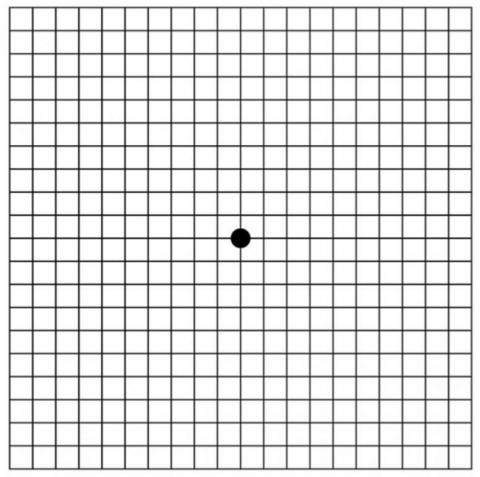
The Amsler grid is an at-home eye test that can help detect early signs of retinal disease such as age-related macular degeneration (AMD). If you have already been diagnosed with AMD, the Amsler grid will help you detect the progression of dry AMD to the wet form of the disease at an early, treatable stage.
How to Use the Amsler Grid:
- Use the Amsler grid pictured here. Or, download and print this free Amsler grid eye test on plain white paper.
- With reading glasses on, hold the grid at a distance that allows you to get most of the lines in focus; it will probably be about 12-14 inches away, the same as book reading distance.
- Cover one eye and focus on the black dot in the middle of the grid.
- Cover the other eye and repeat the test. If the lines appear to be wavy, dim, irregular, or fuzzy, schedule an eye exam immediately.
- Repeat the test once a week. Call us at 1-855-345-6637 to request a magnetic version of the Amsler grid so you can put it on your refrigerator.
It is important to cover or close one eye so that you are testing only one eye at a time. If you use it with both eyes open, the good eye can compensate for an eye with wet AMD, and you won’t notice any abnormalities.
An eye without wet AMD will usually see all the lines as straight. In contrast, an eye with wet AMD will often see some of the lines as curved or even blocked out by a gray, white, or black region. This is caused by fluid that accumulates within or under the retina, which can form a blister, making straight lines look curved. Sometimes the fluid interferes with retinal function enough to cause a gray, white, black, or red “blind spot” in or near the center of the visual field.
The good news is that the fluid, caused by new leaky blood vessels in the retina, can often be dried up by treatment with brolucizumab (Beovu®), aflibercept (Eylea®), ranibizumab (Lucentis®), or bevacizumab (Avastin®). These medicines are injected into the eye through a tiny needle, as often as once per month. Learn more about treatments for macular degeneration.
This test does not replace regular eye exams.
Watch: How to Use the Amsler Grid
If an eye with wet AMD goes untreated for a few months or longer, it can begin to develop retinal scarring. This scarring can lead to irreversible vision loss in parts of the visual field, so it is best to monitor your vision at home at least once a week with the grid and call your retina specialist if you notice a change.
If your eye doctor tells you that you don’t have wet AMD, look at the grid shortly after the exam to determine your baseline. There may be a little waviness of the lines in a few places due to large drusen, semi-solid deposits that form under the retina in AMD. Then, if you check again at a later point and think the area of waviness has increased or a new area has appeared, or you have a new blind spot, it’s time to call the retina specialist.
Even without a grid, you may notice changes in your vision that should prompt a call to your eye doctor:
- reading becomes more difficult
- straight lines look curved (a door frame, for example)
- it becomes harder to see or recognize faces
- computer and TV images are more challenging to see
En español:
Instrucciones para usar Cuadrícula de Amsler (PDF) en español.
About BrightFocus Foundation
BrightFocus Foundation is a premier global nonprofit funder of research to defeat Alzheimer’s, macular degeneration, and glaucoma. Since its inception more than 50 years ago, BrightFocus and its flagship research programs—Alzheimer’s Disease Research, Macular Degeneration Research, and National Glaucoma Research—has awarded more than $300 million in research grants to scientists around the world, catalyzing thousands of scientific breakthroughs, life-enhancing treatments, and diagnostic tools. We also share the latest research findings, expert information, and resources to empower the millions impacted by these devastating diseases. Learn more at brightfocus.org.
Disclaimer: The information provided here is a public service of BrightFocus Foundation and is not intended to constitute medical advice. Please consult your physician for personalized medical, dietary, and/or exercise advice. Any medications or supplements should only be taken under medical supervision. BrightFocus Foundation does not endorse any medical products or therapies.
- Dry AMD
- Eye Health
- Eye Tests
- Wet AMD









